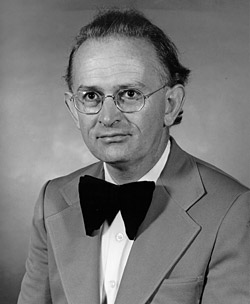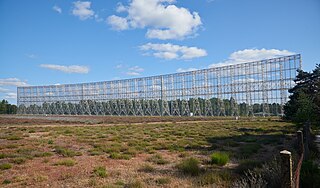- Sullivan, W. T., ed. (2004). "The early years of radio astronomy in France by J.-F. Denisse". The Early Years of Radio Astronomy: Reflections Fifty Years After Jansky's Discovery. Cambridge University Press. pp. 303–316. ISBN 9780521616027. pbk reprint
Related Research Articles

Radio astronomy is a subfield of astronomy that studies celestial objects at radio frequencies. The first detection of radio waves from an astronomical object was in 1933, when Karl Jansky at Bell Telephone Laboratories reported radiation coming from the Milky Way. Subsequent observations have identified a number of different sources of radio emission. These include stars and galaxies, as well as entirely new classes of objects, such as radio galaxies, quasars, pulsars, and masers. The discovery of the cosmic microwave background radiation, regarded as evidence for the Big Bang theory, was made through radio astronomy.

The Paris Observatory, a research institution of the Paris Sciences et Lettres University, is the foremost astronomical observatory of France, and one of the largest astronomical centers in the world. Its historic building is on the Left Bank of the Seine in central Paris, but most of the staff work on a satellite campus in Meudon, a suburb southwest of Paris.
The Bureau des Longitudes is a French scientific institution, founded by decree of 25 June 1795 and charged with the improvement of nautical navigation, standardisation of time-keeping, geodesy and astronomical observation. During the 19th century, it was responsible for synchronizing clocks across the world. It was headed during this time by François Arago and Henri Poincaré. The Bureau now functions as an academy and still meets monthly to discuss topics related to astronomy.

Michel Gustave Édouard Mayor is a Swiss astrophysicist and professor emeritus at the University of Geneva's Department of Astronomy. He formally retired in 2007, but remains active as a researcher at the Observatory of Geneva. He is co-laureate of the 2019 Nobel Prize in Physics along with Jim Peebles and Didier Queloz, and the winner of the 2010 Viktor Ambartsumian International Prize and the 2015 Kyoto Prize.
Yves-André Rocard was a French physicist who helped develop the atomic bomb for France.

Anil Kumar Das FRAS, FNI was an Indian scientist, astronomer. During the International Geophysical Year, observatories in Madrid, India, and Manila were responsible for monitoring solar effects. The Kodaikanal Solar Observatory in South India performed this monitoring using their recently built solar tunnel telescope. Das was the director of the Kodaikanal observatory at this time. In 1960 he was responsible for installing a tower/tunnel telescope at the facility that would be used to perform some of the first helioseismology investigations. The crater Das on the far side of the Moon is named after him.

Gart Westerhout was a Dutch-American astronomer. Well before completing his university studies at Leiden, he had already become well-established internationally as a radio astronomer in the Netherlands, specializing in studies of radio sources and the Milky Way Galaxy based on observations of radio continuum emissions and 21-cm spectral line radiation that originates in interstellar hydrogen. He emigrated to the United States, became a naturalized citizen, and held a number of important scientific and management positions in academic and government institutions.

The Prix Jules Janssen is the highest award of the Société astronomique de France (SAF), the French astronomical society.
The Three Physicists Prize is a physics prize awarded by the École Normale Supérieure (ENS) in Paris and the Eugène Bloch Foundation. It is named in honour of the physicists Henri Abraham, Eugene Bloch and Georges Bruhat, who were successive directors of the physics laboratory at the ENS and all of whom were murdered in Nazi concentration camps between 1943 and 1945. The prize was established by Bloch's widow.

The Nançay Radio Observatory, opened in 1956, is part of Paris Observatory, and also associated with the University of Orléans. It is located in the department of Cher in the Sologne region of France. The station consists of several instruments. Most iconic of these is the large decimetric radio telescope, which is one of the largest radio telescopes in the world. Long established are also the radio heliograph, a T-shaped array, and the decametric array operating at wavelengths between 3 m and 30 m.
Anne-Marie Lagrange, born March 12, 1962 in the Rhône-Alpes region of France, is a French astrophysicist. Lagrange's work focuses on the research and study of extrasolar planetary systems. Lagrange is the holder of numerous scientific awards and honorary decorations, including Knight of the Legion of Honour and is a member of the French Academy of Sciences since 2013.
Jacqueline Henrie͏̈tte van Gorkom is a Dutch radio astronomer and Rutherfurd Professor of Astronomy at Columbia University. Van Gorkom is known for her contributions to the field of galaxy evolution, particularly through observations of neutral hydrogen gas.
Maurice Marc Lévy was a French theoretical physicist known for his work on the Sigma model in particle physics. He was president of the CNES from 1973 to 1976.

Jacques-André Mallet ; also Mallet-Favre; 23 September 1740 – 31 January 1790) was a Genevan mathematician and astronomer.
Jean Kovalevsky was a French astronomer, specializing in celestial mechanics. He is known as a primary initiator and a leader of the Hipparcos space experiment.
Pierre Lacroute (1906–1993), was a French astrophysicist and pioneer of astrometry using satellite experiments. He is known as the first proposer of the Hipparcos space experiment.
Jean Delhaye (1921–2001) was a French astronomer and director of astronomical research at several institutes.
Jean-Loup Delcroix (1924–2003) was a French physicist, specializing in the physics of gases and plasmas.

Jean-Louis Steinberg (1922–2016) was one of the main pioneers of radio astronomy in France. In 1953 he was a co-founder of the project to create the Station de Radioastronomie de Nançay.
References
- ↑ État civil sur le fichier des personnes décédées en France depuis 1970
- ↑ "Fernand Holweck Medal and Prize recipients". Institute of Physics.
- ↑ "Prix Jules Janssen". Société astronomique de France.
- 1 2 3 4 "Jean-François Denisse. membre 1967" (PDF). Académie des sciences, Institut de France.
- ↑ René Édouard-Joseph, Dictionnaire biographique des artistes contemporains, tome 1, A-E, Art & Édition, 1930, p. 388
- 1 2 3 4 5 6 Pecker, Jean-Claude (2014). "Jean-François Denisse | in memoriam | Membres | Nous connaître". Académie des sciences, Institut de France.
- 1 2 3 4 5 6 Lequeux, James. "Obituary. Jean-Francois Denisse 1915–2014". International Astronomical Union (IAU). photograph of Jan Oort, Leo Goldberg, Marcel Minnaert, and J. F. Denisse, available at National Radio Astronomy Observatory website
- 1 2 3 4 5 "Jean-François Denisse". Academia Europaea (The Academy of Europe).
- ↑ "Émile Jacques Blum". International Astronomical Union.
- ↑ l'Observatoire de Paris-PSL (22 May 2015). "Jean-François Denisse honoré par ses pairs" [Jean-François Denisse honored by his peers].
- ↑ Chapman, Jessica M.; Giovaninni, Gabriele; Taylor, Russell; Carilli, Christopher; Hills, Richard; Hirabayashi, Hisashi; Jonas, Justin L.; Lazio, Joseph; Morganti, Rafaella; Nan, Rendong; Rubio, Monica; Shastri, Prjaval; Kellermann, Ken; Ekers, Ronald; Ohishi, Masatoshi (April 2016). "Division B Commission 40: Radio Astronomy". Transactions of the IAU. 29A: 171–184. Bibcode:2016IAUTA..29..171C. doi: 10.1017/S1743921316000739 .
- ↑ Levitt, L. C. (1962). "Review of Théorie des Ondes dans les Plasmas, par J.-F. Denisse et J.-L. Delcroix". Physics Today. 15 (2): 58–59. Bibcode:1962PhT....15b..58D. doi:10.1063/1.3058026. p.59
Jean-François Denisse | |
|---|---|
| 3rd President of the French Space Agency | |
| In office 1967–1973 |
| International | |
|---|---|
| National | |
| Academics | |
| Other | |